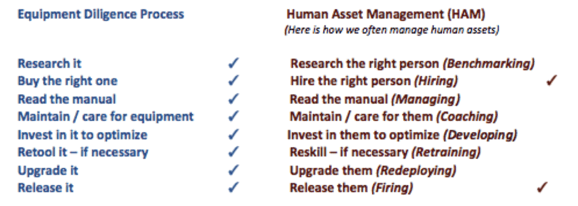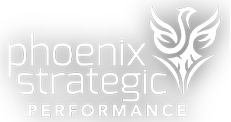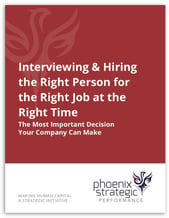Are We Appreciating All Our Assets?
Today, any organization will say that its employees are the most valuable asset to the organization. As new process applications, automation, and artificial intelligence continue to make their presence felt in the workplace, employees keep things running, provide the critical customer interface, and discover the opportunities to leverage technology. When we step back and look at organizations, we tend to find that leadership does not put the same emphasis on their human assets as they would on a physical asset they are acquiring or optimizing. I'm not implying we should treat people like equipment; however, as our most valuable asset, we need to put the same effort into ensuring employees can be most productive while providing an environment where they increase in value to themselves and the organization. Our employees, our human assets, have one key advantage that physical assets do not - they can increase in value over time.
Lessons from the Physical Asset World
When we look at a Human Asset Management Strategy (HAMS), we need to incorporate lessons learned from the physical asset world. Some of the obvious concepts with physical assets may not seem as obvious to the human asset side, but they do, indeed, apply. For example:
- We understand that a piece of equipment has a limit on the amount of quality product it can produce in a specific timeframe. Speed up production, and quality suffers. We don't typically apply this to our human assets. We tend to believe their capacity is unlimited, and an increase in output should not decrease quality. Can the employee, in reality, complete all the tasks given to them?
- We don't expect our physical assets to perform a different function without some intervention, either through physical modification or changes to the instruction set. We consistently expect our employees to take on different functions without the benefit of training (the modification) or clear guidance and understanding of the contribution and the final product (the instruction set). Do they understand what is expected of them and how they contribute to the organization's success?
- We have our physical assets on preventative maintenance and upgrade plans to maintain their relevance and peak performance. We don't always provide the same to our people, "our most valuable asset," through employee development programs such as skills training and leadership development. Has the organization created a path to maximize the potential of the employee?
In the economic challenges that defined the financial crisis beginning in 2008, many organizations found the need to downsize their staff to remain viable. Many use one of these four scenarios:
1. LIFO (Last In, First Out)
2. Reducing the lowest level of employees
3. Politics
4. The extensive use of contractors.
To organizations, these made sense at the time. They were easy and fast to execute and appeared to generate rapid results. Many of these approaches mirror how the organization hired by throwing more bodies at the issues and getting them on-premise quickly. What are the long-term results of these approaches, and is there a different model to consider?
The Value Asset Mindset
When organizations approach their staff with a "Valued Asset" mindset, who need specific capabilities to provide valuable contributions, the concept of Rightsizing takes on an entirely new meaning. Let's look at this process in the steps outlined in the graphic below.
Equipment / Human Asset Management Comparison Model

The Steps
- Research it: We spend significant amounts of time researching a physical asset before acquisition: can it do what we need it to do; can it produce enough, and does the quality of its output meet the standards; can we afford it? We typically don't see an organization putting nearly that much effort into developing a job description (the specifications) for a new hire or existing position. Rather than a list of the tasks the position should do, we need to assess the contribution we want that position to make to the organization: is it purely production and related tactical skills, or do we expect them to contribute strategically? Do we expect this person to become an expert at a limited set of tasks, or is this a feeder position for management and leadership roles? This is not achieved by developing a "copy and paste" job description on the internet but by a process that considers the organization's long and short-term strategic needs and the long-term path for the individual. Time spent in this phase will pay off in the long term. If you can clearly articulate what you need for the organization to be successful, both from a skills standpoint and a cultural standpoint, the following steps in the process will be easier to execute.
- Buy the right one: The equivalent is to hire the right person for the right role with the correct expectations. Have I hired the person that meets the requirements I identified in my research? Not only should the direct supervisor understand the role of this individual, but the entire leadership chain above the employee will need to have a clear understanding of the role and expectations.
- Read the manual: Does the management team for this role have the skills required to allow this person to be effective and meet performance expectations? People are different, and it may take a variety of skill sets to get both the individual and the team to perform effectively. Under the Human Asset Management model, these skills are always considered - we're working to develop the employee into an appreciating asset!
- Maintain / Care for the equipment: Reading the manual is the management side of the scale, and coaching is the maintenance and care side of the scale. Too much of either one leads to an imbalance. While the management process focuses on getting things done, coaching focuses on getting the most value from the employee for the organization. It's developing the understanding of that employee, as an individual, what drives them, their long-term objectives, do they want to be the best at what they do or seek a more significant role?
- Invest in it to optimize: This is the continuous investment in the employee to increase their value to the organization. The leadership team should now continually understand how to constantly increase the employee's value through management and coaching. Here is where we develop the employee into an appreciating asset. If they want to be the best at what they do, what training do I need to provide them so they can continually build their skill set? If they're going to advance to positions of more responsibility, what leadership training do they need, and how do I give them assignments that allow them to grow and exercise these skills? Create an individualized development plan for each employee and execute the plan.
- Retool it, if necessary: At the employee level, this is the equivalent of developing new skills in the employee. This is retraining. The current business world is dynamic and changes faster than has historically occurred. It's not just competition anymore - it's disruption. Which of my employees has the desire to learn a new skill? Do they have the desire to change to meet the new challenges? Do they have the ability to change? Will the fundamental skills that allow them to perform well in their current position also enable them to excel in new roles? Will they continue to be an appreciating asset?
- Upgrade it: Leverage the investment in the steps above to redeploy the individual to a new role. Does the individual’s expertise make them a good candidate for a new role in product development? Does their process knowledge make them a candidate for a quality and productivity improvement position? Does their ability to see the big picture and assess outside influences make them the right candidate for a more strategic role?
- Release it: Is the current environment no longer relevant to the individual? If an individual is not providing value to the organization and the above actions have been taken, perhaps it's time to release the individual. Today, with rapid change, organizations often need different skill sets that the employee does not have. What if the employee is unwilling or unable to develop necessary skills or knowledge sets? If nothing changes, there is no benefit to either side in maintaining the status quo. If an employee can't be successful in your environment, allow them to find a role that meets their needs either outside your department or outside your organization.
The Human Asset Mindset and the Rightsizing Approach
We have outlined a framework for building a high-capacity employee base, but you promised a rightsizing approach. They are both the same. If you have used this approach in building your talent pool, you should not need to ‘rightsize’ since you should already have employees that are value creators leading to organizational and financial growth. If you have not grown with this approach, use it to assess your key performers. Keep those employees with the capabilities to sustain and grow the organization. This approach is not easy. It is, however, an evaluation that requires leadership to commit to creating a sustainable, high-capacity organization in the face of change, growth, or adversity.
How Would This Look?
Throw out the job descriptions you have and look at the skills you need to continue to move forward. Are the right people in the right positions? Are they being managed correctly, and is there an opportunity and a desire for the employee to learn and adapt to the new environment? Can the organization make the investment needed for this to happen? Based on these criteria, the final and key question after evaluating the individual is: Would I hire this individual again?
We invite you to download our latest eBook: "Human Asset Management Strategy: A New Approach," which provides a multifunctional operational guide to human capital capacity planning. You can also schedule a complimentary assessment with a member of our team.
Guest Blog Contributor:

Wayne Haggstrom has more than 30 years of experience in technology planning and program management for organizations ranging from the Department of Defense and Fortune 100 companies to privately-held corporations. He has worked with organizations to establish the value of their technology initiatives, strategic direction, executive leadership development, waste reduction, process improvement, and project management. Wayne works with IT organizations to help them establish a more business-centric approach and demonstrate their value to the C-suite.
Wayne has a Masters in Information Systems Management from Webster University and a BS in Civil Engineering from The Ohio State University. He is a certified Project Management Professional, Certified Six Sigma Black Belt through Johnson Controls, a Certified Quality Facilitator, and Lean/Cycle Time Reduction through The Total Quality Institute. He is also a Certified Sustainable Building Advisor. He has been an instructor for Management and Executive Leadership Development and Sustainable Building Concepts and Methods. He is a Senior member of the American Society for Quality and a member of the Project Management Institute.





